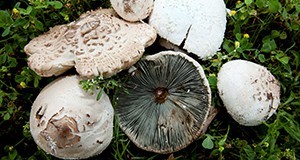Abstract
The “false parasol” or “green-spored parasol” mushroom (Chlorophyllum molybdites) is a poisonous mushroom that is the most common cause of mushroom poisoning in the United States. This mushroom is widely distributed throughout Florida and the southeastern United States. It commonly creates a complete or incomplete “fairy ring” in lawns, grassy areas, and open woods. When mature, the green-spored parasol mushroom has a large cap, a ring around its stem, and a greenish color on the underside of its gills. This four-page fact sheet describes the morphology, ecology, and distribution of the green-spored mushroom as well as its toxicology and how to treat poisoning from this mushroom. Written by Lisbeth Espinoza and Matthew E. Smith, and published by the Plant Pathology department, January 2016.
PP324/PP324: The Green-Spore Poison Parasol Mushroom, Chlorophyllum molybdites (ufl.edu)
References
Augenstein, W. L. 1994. "Chlorophyllum molybdites." In: Handbook of Mushroom Poisoning: Diagnosis and Treatment. Spoerke, D. G. & Rumack, B. H. (Eds.). CRC Press.
Berger, K. J., and D. A. Guss, D. A. 2005. "Mycotoxins revisited: Part II." The Journal of Emergency Medicine 28(2): 175-183. https://doi.org/10.1016/j.jemermed.2004.08.019
Bessette, A.E., W.C. Roody, A.R. Bessette, D.L. Dunaway. 2007. Mushrooms of the Southeastern United States. Syracuse University Press.
Beug, M. W. 2004. "An Overview of Mushroom Poisonings in North America." The Mycophile 45(2): 4-5.
Blayney, D., E. Rosenkranz, and A. Zettner. 1980. "Mushroom poisoning from Chlorophyllum molybdites." Western Journal of Medicine 132(1): 74.
Eilers, F. I., and L.R. Nelson. 1974. "Characterization and partial purification of the toxin of Lepiota morganii." Toxicon 12(6): 557-563. https://doi.org/10.1016/0041-0101(74)90187-1
Kimbrough, J. W. 2000. Common Florida Mushrooms. University of Florida, Extension Institute of Food and Agricultural Sciences.
Kuo, M. 2005. Chlorophyllum molybdites. Retrieved from the MushroonExpert.com Web site: http://www.mushroomexpert.com/chlorophyllum_molybdites.html (Visited May 2014)
Moreno, G., A. Bañares, and M. Heykoop. 1995. "Macrolepiota molybdites (Meyer: Fr.) comb. nov., new to the Canary Islands." Mycotaxon 54(3): 467-471.
Richard, J. L. 2007. "Some major mycotoxins and their mycotoxicoses - An overview." International Journal of Food Microbiology 119(1): 3-10. https://doi.org/10.1016/j.ijfoodmicro.2007.07.019
Stenklyft, P. H. and W.L. Augenstein. 1990. "Chlorophyllum molybdites - severe mushroom poisoning in a child." Clinical Toxicology 28(2): 159-168. https://doi.org/10.3109/15563659008993488
Zoberi, M. H. 1972. Tropical macrofungi, some common species. Hafner Pub. Co. https://doi.org/10.1007/978-1-349-01618-1

